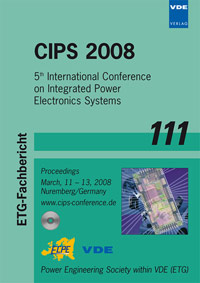Low-Temperature Sintering of Nanoscale Silver Paste for Power Chip Attachment
Conference: CIPS 2008 - 5th International Conference on Integrated Power Electronics Systems
03/11/2008 - 03/13/2008 at Nuremberg, Germany
Proceedings: CIPS 2008
Pages: 5Language: englishTyp: PDF
Personal VDE Members are entitled to a 10% discount on this title
Authors:
Lu, Guo-Quan; Calata, Jesus N.; Lei, Thomas G. (Center for Power Electronics Systems)
Lu, Guo-Quan (The Bradley Department of Electrical and Computer Engineering)
Lu, Guo-Quan; Calata, Jesus N.; Lei, Thomas G. (Department of Materials Science and Engineering, Virginia Polytechnic Institute and State University, Blacksburg, VA, 24061, USA)
Abstract:
European electronic manufacturers, particularly those in power electronics, are aggressively implementing a silver sintering technology for interconnecting semiconductor chips. It has been shown that power modules with sintered chip-attachment have 3x better performance, 5x better reliability, and higher chip junction temperature up to 175oC. However, because of the use of commercial thick-film silver pastes in the process, a serious drawback of the sintering technology is the need of a high quasi-static pressure (~ 40 MPa) to lower the sintering temperature to about 250oC. Using the large pressure complicates the manufacturing process and places critical demands on substrate flatness and chip thickness. In this paper, we describe a strategy of using nanoparticles of silver to lower its sintering temperature without any applied pressure. From the science of sintering, driving force for densification of a particle compact increases with decreasing particle size, thus the densification rate—a product of thermodynamic driving force and kinetics—could still be high at low temperatures even with low atomic diffusion rate. We formulated a uniform silver paste containing 30 to 50 nm silver particles. The sintered attachment at temperatures below 275oC without applying any pressure had a density of about 80% and a uniform distribution of micron-sized pores. The sintered chip-attachment had die-shear strength over 20 MPa, and it showed little change after aging at 300oC for 400 hours. Temperature-cycling tests have been performed and results are presented in this paper. Based on the results, we believe that the nanoscale silver paste can enable a quick adaptation of the low-temperature silver-joining technology for manufacturing electronics products.


